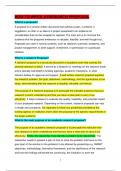HOW TO WRITE A RESEARCH PROPOSAL
What is a proposal?
A proposal is a concise written document that outlines a plan, a scheme, a
suggestion, an offer or an idea of a project presented to an audience for
consideration that can be accepted or rejected. The main aim is to convince the
audience that the proposed endeavour is valuable, feasible, and well-thought-out.
Proposals are used in various contexts, such as research, business, academia, and
project management, to seek support, investment, or permission for a particular
initiative.
What is a research Proposal?
A research proposal is a structured document of academic work that outlines the
planned research in detail. It serves as a blueprint or roadmap for the research study
and is typically submitted to funding agencies, academic institutions, or other
relevant bodies for approval and support. A well-written research proposal explains
the research problem, the goal, objectives, methodology, and the significance of the
study, demonstrating that the research is feasible, valuable, and ethical.
The purpose of a research proposal is to persuade the intended audience that your
research is worth undertaking and that you have a clear plan to carry it out
effectively. It helps reviewers to evaluate the quality, feasibility, and potential impact
of your proposed research. Depending on the context, research proposals can vary
in length and complexity. It's important to follow any guidelines provided by the
funding agency or institution and to tailor the proposal to the specific requirements of
the target audience.
What is the main purpose of an academic research proposal?
The purpose of an academic research proposal is to persuade the institution that
your research is worth undertaking and that you have a clear plan to carry it out
effectively. Firstly, the researcher must identify a problem to be researched. The
researcher needs to present a plan of how to solve the problem and focus on the
goal (part of the solution to the problem) to be attained by presenting e.g. SMART
objectives, methodology, theoretical framework, and the significance of the research
and how the findings will benefit the community, the institution or even the
1
, participants themselves. These aspects must be discussed in detail in the proposal
to win over the people the proposal is intended for. The title must be clear and
concise and interesting to invite readers to read the whole proposal and give it some
consideration in order to ultimately accept or approve it.
The components of an academic research proposal
1. The Title: Create a concise, clear and descriptive title that reflects the focus of
your research that intense to solve an identified problem.
2. Introduction: Provide an overview of the research problem or question you
intend to address. State the significance of the research and its potential
contributions to the field. The introduction is the opening section of your research
proposal. Its purpose is to introduce the reader to the research topic, provide a clear
and concise statement of the research problem or question, and explain the
significance of the research. The introduction should grab the reader's attention and
give them a sense of what the proposal is about. It is the opening section that sets
the stage for your research. It provides a clear statement of the research problem or
question, outlines the significance of the study, and establishes the overall context
for the research.
Example: In recent years, there has been a growing concern about the impact of
plastic pollution on marine ecosystems. This research proposal aims to investigate
the distribution and effects of micro plastics in coastal waters, contributing to a
deeper understanding of their potential ecological and human health implications.
What to include:
A hook or opening statement that captures the reader's interest.
A clear and specific research problem or question that your study aims to address.
The significance and relevance of the research problem. Why is it important to
study? What gaps or issues does it address in the field?
A brief overview of the research methodology/approach you plan to use.
Any key terms or concepts that need to be defined for the reader.
2
, What to exclude:
Detailed methodologies or results.
Excessive technical details.
Lengthy literature reviews.
3. Overview: The overview section is a concise summary of the entire research
proposal. It briefly outlines the main components of your study, including the
research problem, objectives, methodology, expected outcomes, and significance.
This section is usually placed at the end of the introduction or right before the
methodology section. It outlines the main research activities and gives the reader a
sense of how you intend to conduct the study. This section is like a roadmap for the
rest of the proposal, giving a glimpse of what will be covered in subsequent sections.
Example: This research project will employ a combination of field surveys,
laboratory analysis, and data modelling to assess the spatial distribution of micro
plastics in three selected coastal regions. By integrating environmental monitoring
and ecological assessments, this study aims to identify the sources, transport
pathways, and potential ecological impacts of micro plastics in these areas.
What to include:
A brief summary of the research problem.
Research objectives or aims.
The research methodology and approach.
Expected outcomes or contributions to the field.
The significance of the research.
What to exclude:
Detailed explanations or discussions.
4. Background: The background section of a research proposal provides a
comprehensive overview of the existing literature, theories, and findings relevant to
your research topic. It demonstrates your understanding of the field and helps you
3




